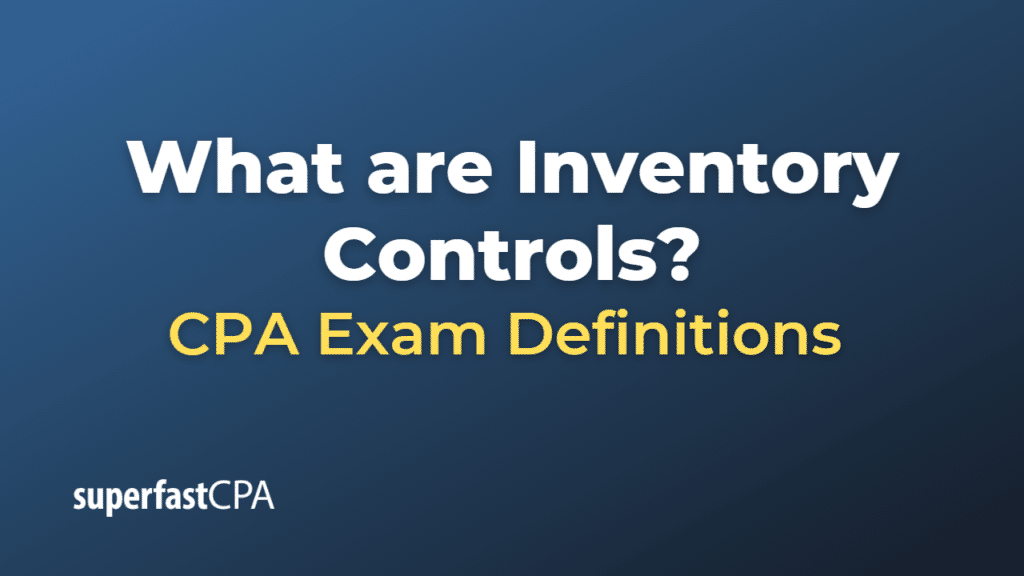Inventory Controls
Inventory controls are specific strategies, methods, and procedures used to manage and oversee a company’s inventory. The main objective is to maximize a company’s use of inventory, minimize waste, and maintain appropriate inventory levels to meet customer demand.
Here are some examples of inventory controls:
- First-In, First-Out (FIFO): This method ensures that the oldest inventory items are sold first, reducing the chance of spoilage or obsolescence.
- Last-In, First-Out (LIFO): In this method, the most recently produced items are sold first. It’s mostly used in industries where inventory items don’t perish or become obsolete.
- Just-In-Time (JIT): This inventory control method aims to minimize inventory levels by scheduling materials to arrive just when they’re needed in the production process, reducing the costs of storing excess inventory.
- Safety Stock: This is the practice of keeping extra inventory on hand to protect against variability in market demand or production delays.
- ABC Analysis: This method classifies inventory into three categories based on its value, with ‘A’ items being the most valuable and ‘C’ items being the least. More control and accuracy is needed for ‘A’ items as they have a significant impact on inventory cost.
- Cycle Counting: This is a process of regularly and systematically counting different areas of inventory to ensure the accuracy of inventory records without having to do a full-scale inventory count.
- Reorder Point Formula: This is a method that calculates the inventory level at which a new order should be placed. It considers the rate of demand and the lead time to receive the order.
- Economic Order Quantity (EOQ): EOQ is a formula that determines the optimal order quantity that minimizes the total inventory holding costs and ordering costs.
Each of these controls can be applied depending on the specific needs and characteristics of a company, including the nature of its products, the predictability of its sales, the reliability of its suppliers, and the capacity of its storage facilities.
Example of Inventory Controls
Let’s take a look at how a bakery might implement some of these inventory control methods:
- First-In, First-Out (FIFO): The bakery uses this method for managing its inventory of baking ingredients like flour, sugar, and yeast. Since these ingredients have a shelf life, it’s important to use the oldest items first to avoid spoilage. So, when new supplies come in, they’re placed behind the older stock.
- Just-In-Time (JIT): To manage the inventory of freshly baked goods, the bakery might use a JIT approach. Rather than baking a large quantity of bread in the morning and hoping it all sells, they might bake smaller batches several times a day, based on observed demand patterns. This approach reduces the risk of unsold goods going stale but requires careful planning and coordination.
- Safety Stock: The bakery might keep a safety stock of certain popular ingredients that are critical to their operations. For instance, they might always try to have an extra bag of flour on hand, just in case there’s a problem with a delivery or a sudden unexpected increase in demand.
- ABC Analysis: The bakery classifies its inventory based on value and importance. ‘A’ items like flour, yeast, and sugar, which are crucial to their operation and constitute a large portion of their inventory value, are closely monitored. ‘B’ items might include secondary ingredients like raisins or nuts, while ‘C’ items might include things like baking paper or decorative items that, despite being necessary, have a relatively low impact on the overall inventory value.
- Reorder Point Formula: To avoid running out of critical ingredients, the bakery uses a reorder point formula. They’ve calculated that they use an average of 20 kg of flour each day, and it takes four days to receive a flour delivery once they’ve placed an order. So, they place a new flour order when they have 80 kg (4 days * 20 kg/day) left.
These are simplified examples, but they illustrate how different inventory control methods can be used in practice. In a real bakery, many other factors would also need to be taken into account, and the bakery would likely use inventory management software to help manage these complexities.













